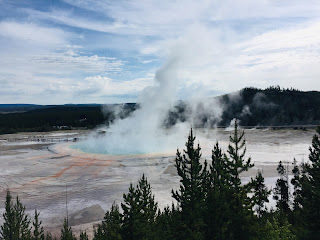Yellowstone Surprises
Everyone has heard of Yellowstone and
its regularly erupting geyser, Old Faithful. So, of course, this
National Park had to be on our list of things to see as we travel the
US this summer. However, I had not anticipated at all what we encountered.
I knew part of the area Yellowstone
covers was once a super-volcano, A huge eruption about 631,000 years
ago made the center collapse, and a 30 by 45 mile caldera or basin
was formed. Magma lies below as close as 3-8 miles (5-13 km) from
the surface. The heat of the magma fuels the park's geysers, hot
springs, fumaroles, travertine terraces, and mudpots. In fact
Yellowstone boasts the world's largest group of such hydrothermal
features, and incidentally there are hundreds of small earthquakes
below ground annually which means these features are in a constant
state of flux.
I'm not intending to give you a
geography lesson, you can visit the park's website to learn more
about it, but I will describe to you what I found the most
breathtaking. It is well worth getting a ranger guided tour to
obtain a deeper understanding whilst visiting. It was from one of
these that I garnered the following information:
Hot springs are the most common in the
park, over half of the world's hot springs are found here. They vary
from frothing boiling water
 |
| Grand Prismatic spring, the largest in the park |
to clear and calm pools of
tremendous depth.
 |
| Beauty Pool |
As thermal activity lessens, the springs can cool
and allow heat loving bacteria called thermophiles to grow. In the
area around Old Faithful, they can grow in temperatures as high
as 167 F (75 C), forming ribbons of color in and around the springs. Research on these lifeforms and the enzymes they produce led to the
development of DNA fingerprinting. Not only useful, they are
stunningly beautiful.
The color can give you an indication
of the heat of the water and what is growing. Blue and clear waters
are extremely hot and may exceed boiling. Yellow indicates
Cyanobacteria, growing at 163 F (73 C) or lower, fungi and algae can
exist when the temperature is at 144 – 140 F (62-60 C) and change
the water to yellow and green. Lilac/purple indicates the growth of
Protozoa and Mosses. Here is Sapphire Pool showing all of the colors.
 |
| Emerald Pool |
As the water cools it also leaves
behind a thin deposit of silicone dioxide (same as found in glass).
It forms white crusts around springs, and bulbous rocks as it is
splashed from geysers, and over time forms cones at the splash area.
Trees caught in the spreading water-flows die, and the base of their trunks, covered in silica, are literally turned into glass.
In other areas of the park, limestone,
deposited when a vast sea covered this area, provides the source of
calcium carbonate which is deposited as travertine from springs as
the waters cool. Hot water has ebbed and flowed and cooled over eons
of time, resulting in terraces and thermophiles which have created
tapestries of color over rock formations that are simply beautiful.
 |
| travertine terracing |
 |
| Canary Spring |
 |
| Minerva Terrace |
Many people come to Yellowstone to hike
in its diverse ecosystems, ranging from near desert vegetation,
sub-alpine meadow, forest, and lakes. The surface of Yellowstone
Lake, the largest lake above 7,700 feet (2350 m) in North America,
hides active hydrothermal features far below, but you can see some
along its shores. This geyser cone's water averages 199 F/93 C, and
depending on snow melt, when the lake level is higher, it may be
below the surface. It is called Fishing Cone, because when first
discovered it was used by tourists as a perch to catch trout, and
then swing around and cook the fish in its boiling pool! Naturally
this is no longer allowed as people were injured by the boiling
water, and of course damaged the fragile cone.
 |
| Fishing Cone |
The Grand Canyon of the Yellowstone
River is 20 miles (32 km) long, 1000
ft (305 m) deep and 1500-4000 ft (450-1200 m) wide, and boasts two splendid waterfalls.
 |
| Yellowstone River and Lower Falls |
Hiking along it
offers pretty dramatic views, including osprey nests, some with
babies waiting for food. Unfortunately the camera did not do baby
osprey justice!
In fact, Yellowstone is all about
incredible views, but not just of hot and cold water features -
traffic stops and avid tourists search out glimpses of wildlife -
like bison, elk, moose, wolves, grizzly and black bears, while
fishermen watch for water fowl, swans and hope to catch cutthroat
trout.
In the ten days we stayed here, we did
all of the above, except the fishing.
 |
| View of Grand Tetons |
We even managed a day-trip to
the inspiring Grand Tetons and Jackson Hole in Wyoming, watched the 4th of July parade in West Yellowstone, and enjoyed a
couple of bars and live music.
One caveat, which caught us by
surprise, was the distances we had to drive between sites. At a max
speed limit of 45, often lower due to traffic stops for everyone to
get out of their cars to view animals in the far distance, it was a
challenge after the fourth day to haul our weary asses to the next
“must see” feature.
But, yes, we were part of that
experience and would not have missed it. And thank goodness we had
rest days in between each foray as the days passed.
Oh, I almost forgot, Old Faithful was predictably spectacular.
Yet for me, the
highlight of Yellowstone was the glorious colors of the hot springs.








Comments
Post a Comment